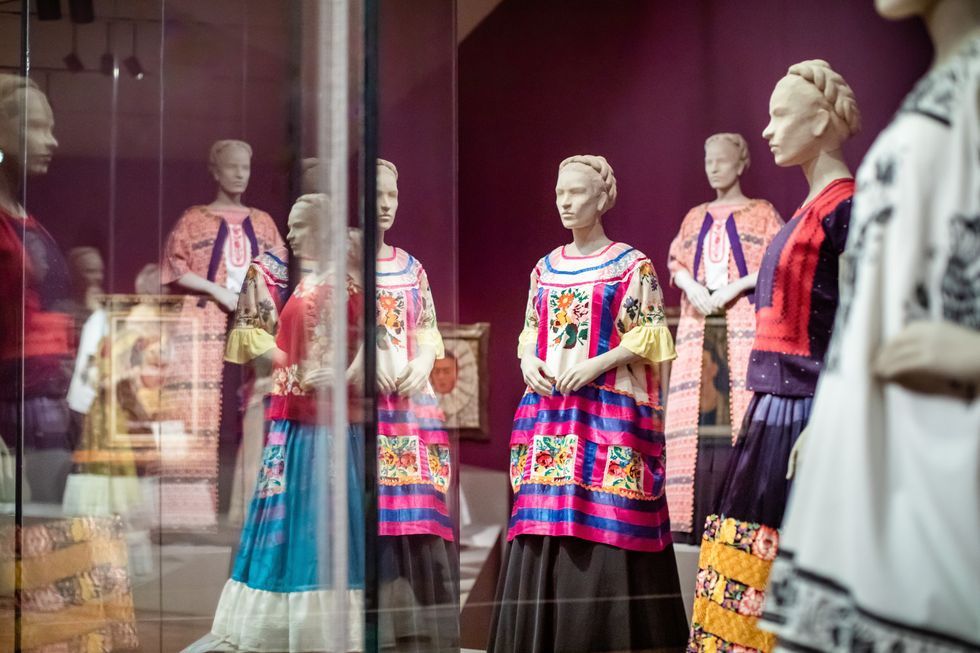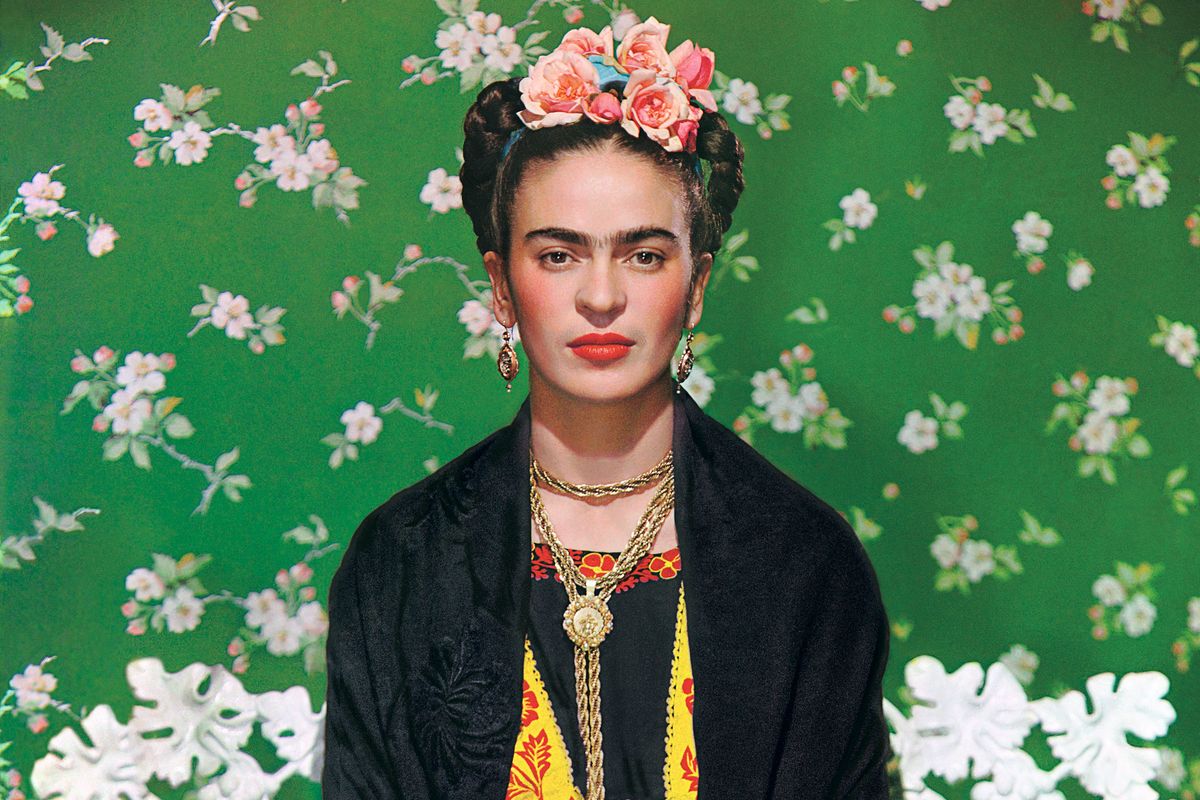Girl, it was so good to finally see you!
Like everyone who was set to attend Frida Kahlo: Appearances Can Be Deceiving in March, my ticket went unused. COVID-19 made sure of that—as every museum, restaurant, bar and boutique in town closed, and we all hunkered down at home. This week for the first time, the de Young Museum welcomes back visitors (with limited capacity and strict safety guidelines). At last, culture can officially be had again.
Can you hear the sound of Frida-philes rejoicing?
And celebrate they should: This look at the Mexican artist and cultural icon is a distinctly personal one (our favorite kind). It features a treasure trove of possessions from La Casa Azul, Kahlo's home in the Coyoacán neighborhood of Mexico City. The Blue House is where she spent most of her life…as in, she was born there and died there (at age 47). It's also the place she famously shared with her also-very-famous husband and muralist, Diego Rivera.
After Kahlo's death in 1954, Rivera had her personal items locked away. They didn't see the light of day until 50 years later when they were rediscovered in the house, which had since become the Museo Frida Kahlo, a constantly sold-out must-see for visitors to CDMX. A selection of these intimate Frida things—photographs, clothing, jewelry, cosmetics, prosthetics, medicines, letters, documents, and drawings—are the lifeblood of the exhibition. Kahlo paintings and objects from the Fine Arts Museums of San Francisco round out and complement the narrative.
Kahlo's striking appearance is known to virtually everyone on the planet, her visage and singular style of dress immortalized in her many self-portraits and through the images by rockstar photographers including Nickolas Muray, Imogen Cunningham, and Edward Weston. Immediately, we recognize the unibrowed face, the flower crowns, bold jewelry, and colorful Mexican garb.
(Courtesy of Gary Sexton Photography for the Fine Arts Museums of San Francisco)
A selection of personal items owned by Frida Kahlo.












Similarly, the basic outline of Kahlo's dramatic life story is well known: A child of the Mexican Revolution, she was first disabled by polio as a toddler and then suffered lifelong injury and serious medical issues, including the eventual amputation of her right leg, due to a bus accident as a teen. She married the wildly important artist Rivera and they traveled around the U.S. together mostly for his work, but ultimately Kahlo became an artist in her own right, known mostly for her surrealist self-portraits. After she died, Fridamania ensued.
This pretty much sums up the extent of my pre-exhibit knowledge of Frida Kahlo. (What? That Salma Hayek biopic was like 20 years ago.) But as I whirled through the easy-to-navigate exhibit—there was only one social-distancing kerfuffle—with eyes wide and open heart, I learned much about this enigmatic woman. She made art out of pain (those painted plaster corsets!), and her identity was shaped by a mix of politics, gender, disability, and a fierce love of her native country.
Blown away, I was.
No surprise, my favorite section was the final one, where 20 traditional Tehuana looks from Kahlo's wardrobe steal the spotlight. The indelible and intentional way she put her outfits together is the ultimate form of sartorial self-expression, a huge part of her appeal for many. The regiment of mannequins are clothed in long ruffed skirts, shawls (rebozos) and huipils, aka boxy blouses/tunics. Colors are bright, prints are many. And it's really cool to see a garment IRL next to the masterpiece in which it's featured.
Here are a few more FK things I learned/loved:
- Her dad was German, and a photographer. Many of the amazing black-and-white childhood photos of Frida and her family were taken by her father. Kahlo changed his name from Carl Wilhelm to Guillermo when he immigrated to Mexico as a young adult in the 1890s.
- Those signature flower crowns weren't crowns at all. Mesmerized, I watched the silent footage of La Casa Azul playing on the giant screen in the middle of the exhibit. Rivera walks up to his wife with a fistful of fresh blooms. She sweetly pecks his cheek and then grabs a stem, one at a time, and effortlessly weaves it into her glorious, raven tresses. Voila, in mere seconds, her chic crown-not-crown is complete.
- She loved her doctors and paid them in artwork. My favorite: Still Life, painted for her dentist and friend Samuel Fastlicht in 1948. This colorful piece stars beautifully ripe fruits and vegetables clustered around a tiny ceramic dog that's one of the ancient pre-Hispanic pieces Kahlo and Rivera collected. Also on display is the famous Self-Portrait Dedicated to Dr. Leo Eloesser (1940). Dr. E was not just her doctor but her best friend and confidante.
- She took pride in her unibrow and embraced her mustache. Kahlo refused to pluck her eyebrows; instead, she emphasized and exaggerated them in her self-portraits. She was also A-OK with her visible mustache—her androgynous features were integral to her identity and complex sexuality. She said: "Of my face, I like the eyebrows and the eyes…I have the mustache and, in general, the face of the opposite sex."
- San Francisco deeply impacted her life. Her first visit to SF came in 1930 while accompanying her husband as he worked on murals in the city. Just 23 at the time, Kahlo was inspired by the ethnic diversity of the city and began dressing in her now-famous indigenous Tehuana style. (The voluminous garments were also a sly way to hide her disability.) She also began painting seriously during this trip. She returned to the city in 1940 for medical treatment and to remarry Rivera—they had divorced the year before. P.S. Kahlo referred to the U.S. as Gringolandia (lol).
OK, your turn! Reserve a ticket and see what objects and stories resonate with you. I'll be here, ahem, growing out my eyebrows. P.P.S. The Frida gift shop is so good.
// Frida Kahlo: Appearances Can Be Deceiving runs at the de Young Museum through February 7th, 2021; 50 Hagiwara Tea Garden Drive (Golden Gate Park), deyoung.famsf.org





















